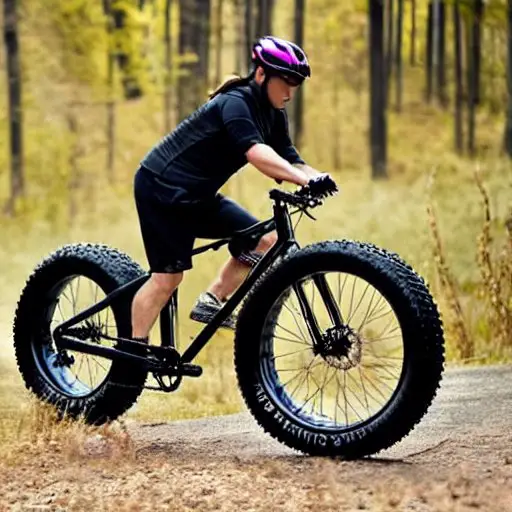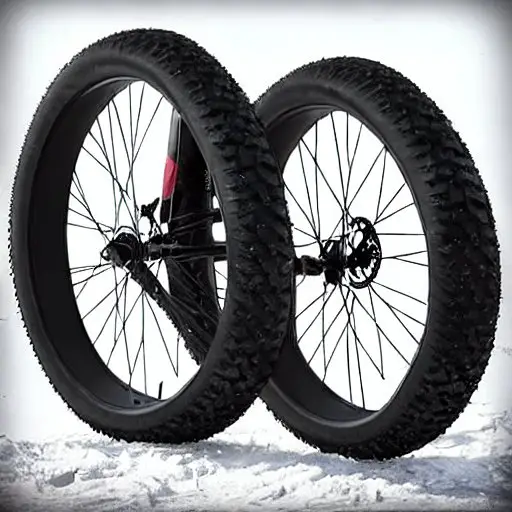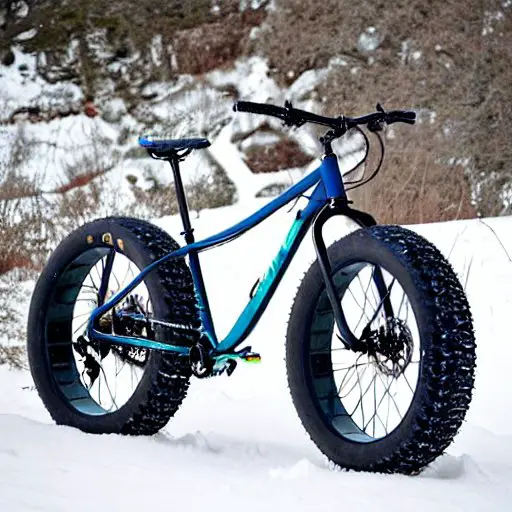I remember the first time I laid eyes on a fat bike.
It was love at first sight.
I mean, what’s not to love? Those chunky tires, that beefy frame, the promise of unstoppable adventures on any terrain.
It was like the perfect partner for my adventurous spirit.
So, naturally, I went ahead and bought one.

And let me tell you, it was a mistake.
Don’t get me wrong, I had some amazing rides on it. But in the end, the disadvantages outweighed the advantages.
Are fat bikes all they’re cracked up to be?
No, and here’s why:
Disadvantage #1: Heavy as a Hippopotamus
Sure, those fat tires give you a lot of grip, but they also weigh a ton.

Seriously, my fat bike felt like it was made of lead. Every hill felt like a mountain, and I was exhausted after just a few miles. I might as well have been dragging a hippopotamus behind me.
Disadvantage #2: Slow as Molasses
Fat tires also mean a lot of rolling resistance. Translation: you’re not going to be breaking any speed records on a fat bike.
I mean, if you’re into leisurely rides and taking in the scenery, that’s cool. But if you’re trying to get anywhere in a reasonable amount of time, forget about it.

For me, the last straw came on a ride in the mountains.
I was huffing and puffing up a steep incline, the bike feeling heavier than ever.
Then, on the way down, I hit a patch of loose gravel and wiped out hard. It was painful, and it made me realize that the cons of a fat bike outweighed the pros.
Disadvantage #3: Limited Trail Access
One of the big selling points of fat bikes is that they can go anywhere.
Well, that’s not entirely true. Sure, you can ride them on sand, snow, and mud.
But when it comes to narrow singletrack trails, forget about it.
Those fat tires make it almost impossible to maneuver around tight turns and obstacles.
Disadvantage #4: Expensive as Hell
Fat bikes are not cheap.
In fact, they’re some of the most expensive bikes out there. And for what? A bike that’s heavy, slow, and can’t even ride on some of the best trails out there? No thanks.
Disadvantage #5: Hard to Store
Unless you have a garage the size of a small airplane hangar, good luck finding a place to store your fat bike.
Those wide tires and oversized frames take up a ton of space. Plus, good luck trying to fit it on a bike rack or in the trunk of your car.
Disadvantage #6: Maintenance Nightmare
Maintaining a fat bike can be a nightmare.
Those fat tires need a lot of attention, and finding replacement parts can be a challenge. Plus, the extra weight and strain on the bike’s components can lead to more frequent repairs and maintenance.
Disadvantage #7: Not Suitable for Everyone
Let’s face it, not everyone is built for a fat bike. The wide stance and heavier frame can make it difficult for some riders to balance and control the bike.
And for shorter riders, the larger frame can make it almost impossible to find a comfortable riding position.
Disadvantage #8: Not Environmentally Friendly
Those big, fat tires are not exactly eco-friendly.
The larger surface area means more friction and more damage to the trails. Plus, the extra weight means more energy needed to ride, which translates to more carbon emissions.
In short, while fat bikes may look cool and offer some unique advantages, they are not for everyone.
The heavy weight, slow speed, limited trail access, high cost, difficult storage, maintenance issues, limited suitability, and environmental impact make them a questionable choice for many riders.
Ultimately, it’s important to carefully consider your needs and preferences before investing in a fat bike.
Fat Bike vs. Road Bike: The Ultimate Showdown
| Feature | Fat Bike | Road Bike |
|---|---|---|
| Weight | Heavy | Light |
| Speed | Slow | Fast |
| Tire Width | Wide | Narrow |
| Rolling Resistance | High | Low |
| Maneuverability | Difficult | Easy |
| Trail Access | Wide | Limited |
| Cost | Expensive | Varies |
| Storability | Difficult | Easy |
| Off-Road Performance | Excellent | Medium |
| Pavement Performance | Poor | Excellent |
| Beginner-Friendly | No | Yes |
| Bikepacking | Good | Good |
Comparing Fat Bikes to Other Specialized Bikes
When it comes to choosing a bike for a specific purpose, there are many options to consider.
Fat bikes are versatile, but how do they compare to other specialized bikes, such as gravel bikes or downhill bikes?
Let’s take a closer look:
Gravel Bikes
Gravel bikes are designed for riding on unpaved roads, gravel, and dirt paths. They are lighter and faster than fat bikes, but not as stable on loose terrain.
Gravel bikes have narrower tires, typically around 35-40mm, compared to the 4-5 inch tires on a fat bike. They also have a more aggressive riding position and are better suited for longer rides on smoother terrain.
Downhill Bikes
Downhill bikes are built for steep and technical descents. They have long-travel suspension, wide handlebars, and heavy-duty brakes.
Fat bikes, on the other hand, are not designed for extreme downhill riding. They don’t have the same level of suspension as downhill bikes and are not as maneuverable on tight and technical trails.
Mountain Bikes
Mountain bikes are the most versatile type of bike and are designed for off-road riding on a variety of terrain.
They are generally faster than fat bikes and have better handling on technical trails.
However, fat bikes have a wider range of terrain options than mountain bikes.
For example, a fat bike can easily ride on sand or snow, whereas a traditional mountain bike would struggle.
Electric Bikes
Electric bikes, or e-bikes, are becoming increasingly popular for their assisted pedaling power. They can be designed for a variety of riding styles, including fat bikes.
E-fat bikes are equipped with a motor and battery to assist with pedaling, making it easier to ride longer distances or tackle challenging terrain. However, e-fat bikes can be heavier and more expensive than regular fat bikes.
Road Bikes
Road bikes are designed for speed on smooth pavement. They have narrow tires and a lightweight frame. Fat bikes are not designed for road riding and are not as fast or efficient as road bikes.
However, fat bikes can be used for bikepacking, which is essentially off-road touring with a bike. With fat tires, you can carry a heavier load and ride on rough terrain, making it a great option for adventure touring.
In conclusion, each type of specialized bike has its own advantages and disadvantages.
Fat bikes are versatile and can handle a wide range of terrain, but they are not the best option for every riding style. Consider your specific needs and preferences before choosing a bike.
Must-Have Accessories for Bikepacking on a Fat Bike
Looking to explore the great outdoors on your trusty fat bike?
Have you considered bikepacking?
Bikepacking is a form of adventure travel that combines mountain biking and camping, allowing you to immerse yourself in nature and experience the thrill of exploring remote destinations on two wheels.
And if you’re going bikepacking on a fat bike, having the right accessories can make all the difference in your comfort and safety.
In this post, I’ll explore some must-have accessories to make your bikepacking adventure on a fat bike a success.
Bikepacking Bags
You’ll need a set of bikepacking bags to carry all your gear on your fat bike.
Look for bags that are designed specifically for fat bikes, as they’ll have wider straps and attachments to accommodate the larger tires.
Examples include the Revelate Designs Terrapin System or the Apidura Backcountry Series.
Frame Bag
A frame bag is a great addition to your bikepacking setup, as it allows you to carry heavier items closer to the center of gravity for better balance.
Look for a bag that fits snugly in the triangle of your fat bike’s frame, such as the Porcelain Rocket Mr. Fusion or the Rockgeist Turchese.
Handlebar Bag
A handlebar bag is a convenient way to carry items you need quick access to, such as snacks or a camera.
Look for a bag that attaches securely to your handlebars and has a waterproof or water-resistant construction, such as the Ortlieb Handlebar Pack or the Salsa EXP Series Anything Cradle.
Saddle Bag
A saddle bag is another great option for carrying heavier items, such as a sleeping bag or a tent.
Look for a bag that attaches to your seat post and saddle rails, such as the Topeak BackLoader or the Blackburn Outpost Elite.
Bike Lights
If you plan to do any riding at night or in low-light conditions, you’ll need a set of bike lights to stay safe and visible.
Look for lights that have a high lumen output and a long battery life, such as the NiteRider Pro 1800 or the Lezyne Macro Drive 1100 XL.
Tire Pump
When you’re riding on fat tires, it’s important to have a tire pump that can handle the larger volume of air.
Look for a pump that has a high-volume mode and a built-in pressure gauge, such as the Lezyne Steel Floor Drive or the Topeak JoeBlow Fat.
Multi-Tool
A multi-tool is an essential item for any bikepacking adventure, as it allows you to make on-the-fly adjustments or repairs.
Look for a tool that has a variety of hex keys, screwdrivers, and a chain tool, such as the Crankbrothers M19 or the Park Tool IB-3.
Water Filtration System
When you’re out in the wilderness, finding clean drinking water can be a challenge. A water filtration system can help you stay hydrated without having to carry large quantities of water with you.
Look for a system that is compact and lightweight, such as the Sawyer Squeeze or the Katadyn BeFree.
Bike Computer/GPS
A bike computer or GPS can help you navigate your route and track your progress.
Look for a device that is easy to read in daylight and has a long battery life, such as the Garmin Edge 1030 or the Wahoo Elemnt Bolt.
Bear Spray
Depending on where you’re bikepacking, you may encounter bears or other wildlife.
Having a can
of bear spray on hand can provide added peace of mind and protection.
Look for a spray that is easy to access and has a spray range of at least 30 feet, such as the Counter Assault Bear Deterrent or the UDAP Bear Spray.
First Aid Kit
Accidents can happen when you’re out in the wilderness, so it’s important to have a first aid kit with you.
Look for a kit that includes items such as bandages, antiseptic wipes, and pain relievers, such as the Adventure Medical Kits Ultralight/Watertight .7 or the VSSL First Aid Mini.
By investing in these must-have accessories for bikepacking on a fat bike, you can ensure a safe and comfortable adventure, no matter where your fat tires take you.
FAQs
Can fat bikes be used for commuting?
Technically, yes. But unless your commute involves sand, snow, or mud, there’s really no point. You’ll be much better off with a regular bike that’s faster, lighter, and easier to maneuver.
Are fat bikes good for beginners?
In my opinion, no. Fat bikes are heavy, slow, and hard to handle.
Plus, they’re expensive. If you’re just starting out, get a regular mountain bike or road bike instead.
Can fat bikes ride on pavement?
Sure, they can. But again, there’s really no point.
Fat bikes are designed for off-road use and are not optimized for pavement riding. Their wide tires create more rolling resistance, making them slower and less efficient on paved surfaces.
What is the ideal terrain for a fat bike?
Fat bikes are best suited for soft, loose, or slippery terrain, such as sand, snow, mud, or loose rocks. They can also handle technical terrain with large obstacles and drops.
However, they may not perform as well on narrow, twisty singletrack trails or steep climbs due to their weight and bulkiness.
Are fat bikes good for bikepacking?
Yes, fat bikes can be a good choice for bikepacking due to their ability to handle a variety of terrain and carry heavier loads.
However, their weight and bulkiness may make them more challenging to pack and transport.
Can I convert my regular bike into a fat bike?
It is possible to convert a regular bike into a fat bike by swapping out the wheels and tires with wider ones.
However, this can be expensive and may not provide the same level of performance and handling as a purpose-built fat bike.
It’s best to consult a bike mechanic before attempting a conversion.

